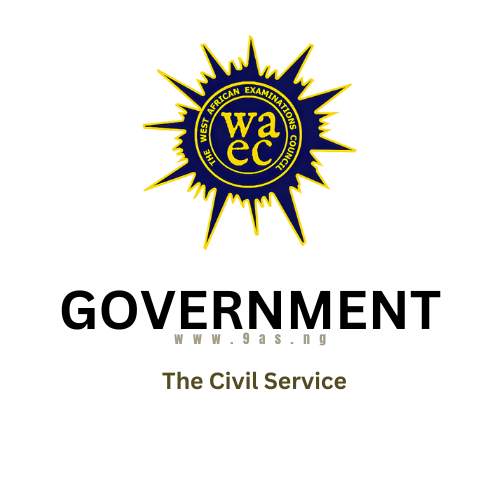THEORY
1. What are the major differences between the civil service and public service?
2. Discuss the characteristics of the civil service.
3. Discuss the main criticisms against the Nigerian civil service.
4. Identify the characteristics of the Civil Service
5. Why is it important for the Civil Service to be politically neutral?
6. (a) Explain the term bureaucracy (b) State five functions of a modern civil service.
7. Identify any four major functions of Civil/Public Service Commission.
10. (a) What is civil service?
(b) Explain the structure of the civil service.
11. In what five ways is the civil service different from the public corporation?
OBJECTIVES
1. Another word for red-tapism is
A. democracy.
B. autocracy.
C. idiosyncrasy.
D. bureaucracy.
2. The civil service is an institution for
A. carrying out private organizational goals.
B. effecting civil society policies.
C. formulating and executing public policies.
D. initiating bureaucratic private agenda.
3. Anonymity of civil servants means that they
A. should be seen and heard.
B. should engage in partisan politics.
C. should work hard for their superiors.
D. do not take praise or blame for their performance.
4. The principle of anonymity of civil servants means that they are
A. career officers.
B. not the servants of a particular government.
C. trained for the duties they perform.
D. not credited or blamed for anything they do.
5. The anonymity in the civil service means that a civil servant
A. is above the law of the land.
B. receives neither praise nor blame.
C. should take part in partisan politics.
D. should not be disciplined for any misconduct.
6. Which of the following is a problem of civil service?
A. Red-tapism.
B. Offering professional advice to political leaders.
C. Continuous keeping of records.
D. Changing of government through election.
7. The appointment, promotion and discipline of civil servants are the responsibility of the
A. Civil Service Union.
B. Judicial Service Commission.
C. Civil Service Commission.
D. Electoral Commission.
8. Red tapism in the civil service refers to
A. the use of red tapes on legal documents.
B. slowness of action.
C. the co-operation between civil servants and politicians.
D. the politicisation of the civil service.
9. The anonymity of a civil servant means that he
A. is above the law of the land.
B. should take part partisan politics.
C. receives neither praise nor blame publicly.
D. should be prosecuted for professional misconduct.
10. Which of the following functions is performed by the civil service?
A. Enactment of laws.
B. Settlement of disputes.
C. Appointment of ministers.
D. Implementation of policies.
11. The political neutrality of civil servants implies that they
A. are not allowed to vote.
B. Have permanent tenure.
C. Are not allowed to join any organisation or group.
D. Are not allowed to be involved in partisan politics.
12. Which of the following does not belong to the Civil Service?
A. The cabinet office.
B. Nigeria Civil Aviation Authority.
C. The Governor’s office.
D. The Establishment Department.
13. Which of the following is the duty of a civil servant?
A. Loyalty to the government.
B. Public association with a political party.
C. Advising on policy formulation.
D. Supporting the party in power.
14. Who among the following is a civil servant in Nigeria?
A. The managing director of a bank.
B. A director in the Ministry of Defence.
C. A major in the Army.
D. A Commissioner of Police.
15. Neutrality of civil servants implies that they should
A. belong to political parties of their choice.
B. be recruited on the basis of merit.
C. serve any commission.
D. be appointed on permanent basis
16. Neutrality in the civil service means that
A. the government can seek to replace top civil servants.
B. officials can only be removed from office due to ill-health.
C. civil servants should be loyal to the government and nonpartisan.
D. officials need to defend the budget in parliament.
17. Red-tapism in the civil service is a product of
A. Democracy.
B. Autocracy.
C. bureaucracy.
D. theocracy.
18. Which of the following is a civil/public servant
A. House majority leader.
B. Clerk of the House.
C. Party whip.
D. Minister of education.
19. Which of the following is not a problem of civil service?
A. Red- tapism.
B. Over-devotion to precedence.
C. improper keeping of records.
D. Advising political leaders.
20. The regionalization of the Civil Service in Nigeria could be traced to the
A. Nigerian Council of 1914.
B. Clifford Constitution of 1922.
C. Richard Constitution of 1946.
D. Lyttleton Constitution of 1954.
21. Which of the following is not a function of the police?
A. Enacting laws,
B. Controlling traffic.
C. Protecting public places.
D. Prosecuting criminals in law court.
22. The anonymity of a civil servant means that he
A. receives neither praise nor blame publicly.
B. is above the laws of the land.
C. should not take part in union activities.
D. should not be disciplined because of his expertise.
23. The Civil Service is an administrative institution of
A. the executive arm of government.
B. public blog corporations.
C. Para-military organization.
D. a business enterprise.
24. Which of the following is a feature of the civil service?
A. Disloyalty.
B. Impartiality.
C. Political activism.
D. Temporary tenure.
25. Anonymity in the civil service means that an officer
A. should work without complaint.
B. should not be heard or seen.
C. does not take praise or blame for his performance.
D. remains in office indefinitely.
26. All of the following are features of the civil service except
A. Anonymity.
B. Political neutrality and impartiality.
C. Security of tenure and permanence.
D. Political maturity and participation.
27. Civil servants are recruited, controlled, promoted and disciplined by the
A. teaching service commission.
B. public complaint commission.
C. public service commission.
D. code of conduct bureau.
28. Red-tapism refers to
A. excessive use of formalities in administration.
B. cutting of the tape during official ceremonies.
C. measurement with tape rule in government land survey.
D. use of red carpet for important dignitaries.
29. Neutrality of civil servants means that they
A. are free to do whatever they like.
B. should not take part in politics.
C. can be seen but must not be heard.
D. cannot be tried in court for misbehaviour.
30. The non-involvement of civil servants in partisan politics is related to
A. anonymity.
B. neutrality.
C. permanence.
D. impartiality.
31. Red tapism can be explained as
A. the decentralized way of taking decisions.
B. a flexible way by which government decisions are taken.
C. the rigid dependence on routine by civil servants.
D. management by objectives.
32. Anonymity of the civil servants means that they
A. are free from their political heads.
B. are to be seen but not to be heard.
C. cannot vote for any political party.
D. are to execute government policies.
33. The class that controls and supervises the activities of the executives class in the civil service is
A. clerical class.
B. manipulative class.
C. professional class.
D. administrative class.
34. The agency responsible for investigating allegations of maladministration and punishing offending career officers in the executive is the
A. Federal Character Commission.
B. Ethics Commission.
C. Judicial Commission.
D. Public/Civil service commission.
35. The anonymity of civil servants means that they should not be
A. prosecuted for any professional misconduct.
B. disciplined because of their expertise.
C. above the law of the land.
D. praised or blamed publicly.
36. The recruitment of personnel into the civil service by the public/civil service commission prevents
A. political patronage.
B. bribery and corruption.
C. overstaffing.
D. bureaucracy.
37. Before the Civil Service reforms of 1988, the most prestigious and highest paid grade in the Nigeria Civil Service was the
A. clerical and manipulative class.s
B. administrative class.
C. executive class.
D. messengerial class.
38. The body responsible for the execution of the policies of government is the
A. Pressure Group
B. Civil Service.
C. Constitutional Conference.
D. Electoral Commission.
39. Which state institution serves as a link between the government and the people?
A. Office of the President
B. The Civil Service
C. The Judiciary.
D. The Church
40. An institution under the executive arm of government responsible for formulating and
implementing government policies is the
A. public service.
B. public corporation.
C. civil service.
D. judicial service.
41. The institution establish by the constitution to be responsible for recruiting personnel into the Civil
Service is the
A. Personnel Management Office.
B. Office of the President.
C. National Labour Commission.
D. Public Service Commission.
42. The police perform all the following functions except
A. public execution of law breakers.
B. prosecuting law breakers.
C. protection of life and property.
D. enforcement of law and order.
43. One way of improving productivity in the Public Service is through
A. promotion without examination.
B. higher salaries and allowances.
C. increase in working hours.
D. open door policy.
44. The Civil Service helps the government to
A. recruit personnel for the army.
B. develop and implement policies effectively.
C. maintain instability in the state.
D. stay in power for a long time.
45. A citizen is barred from active politics when employed as a
A. university lecturer
B. priest.
C. civil servant.
D. journalist.
46. The determination and execution of government policies is the core function of the
A. Public Complaint Commission
B. Public Service Commission
C. Civil Service
D. Judicial Service
47. The administrative head of the ministry is the
A. official of the ruling government
B. general manager
C. permanent secretary
D. chief coordinating officer
48. The official routine observed in carrying out functions in the civil service is commonly known as
A. official order
B. standard order
C. bureaucracy
D. command
49. The Public Service Commission performs the following functions except
A. imposition of income tax
B. discipline of personnel
C. welfare of a personnel
D. advisory body
50. The civil service is different from the public service in terms of
A. conditions of service
B. educational qualification
C. personality and stature
D. political affiliation



